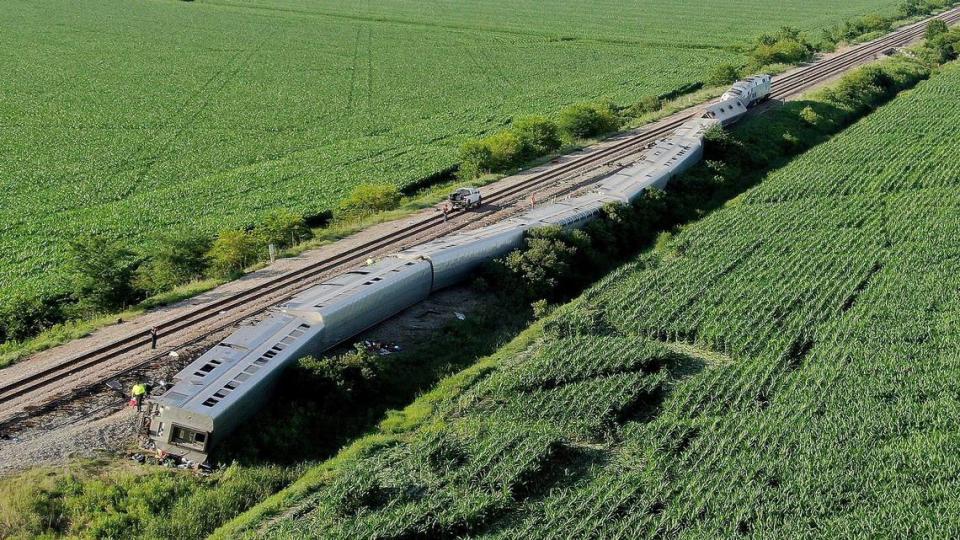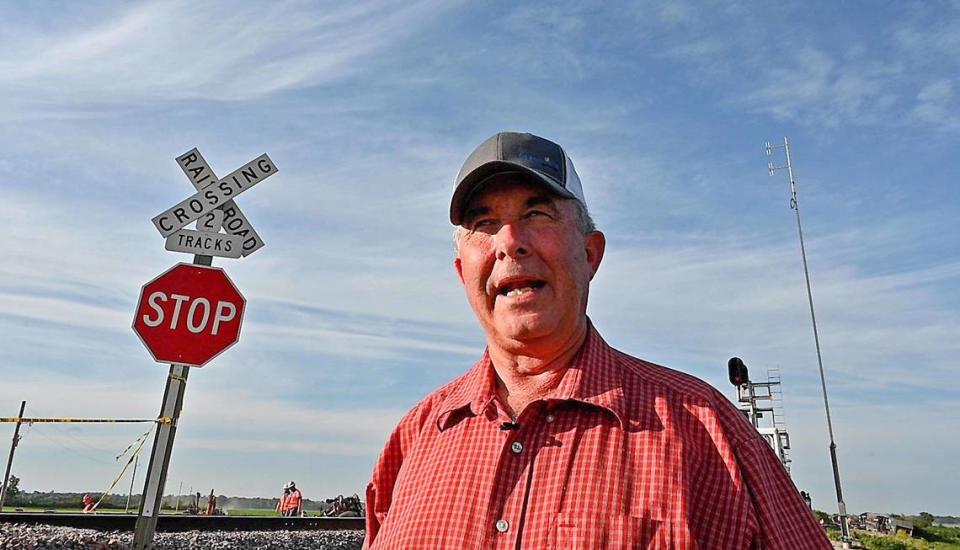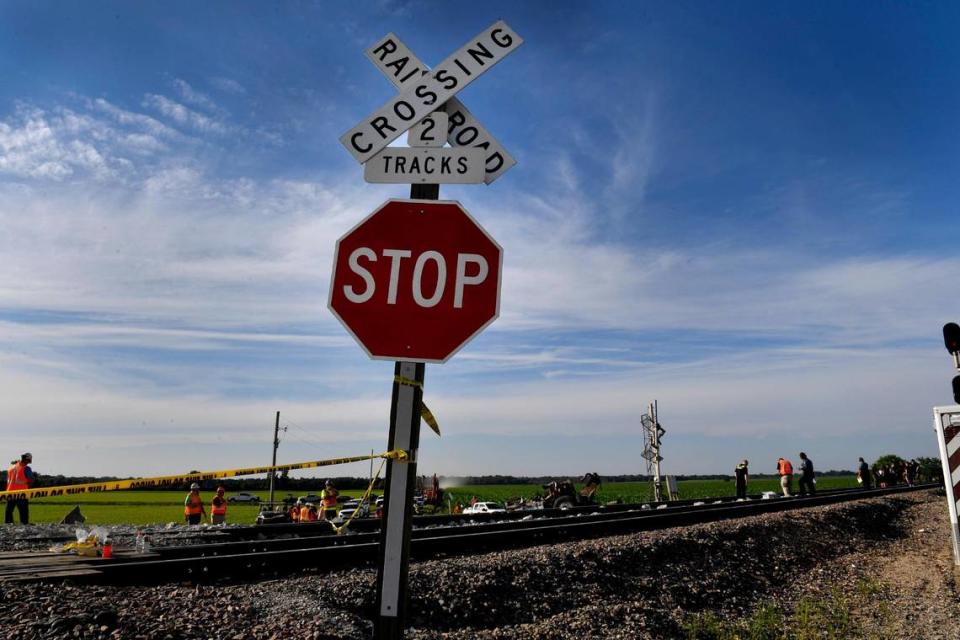Missouri agency never contacted railroad to review crossing, site of deadly Amtrak crash
In March 2021, a small group of men met at a rural railroad crossing in northern Missouri that locals had long been complaining about because of its steep grade and lack of visibility.
A farmer leading the effort to improve the crossing was among those who gathered at the Porche Prairie Avenue Crossing southwest of Mendon. All three Chariton County commissioners were there, along with a safety official with the Missouri Department of Transportation and a representative from a local engineering firm.
In the wake of Monday’s deadly Amtrak derailment that killed four people and injured 150, last year’s meeting at the crossing has taken on new meaning and importance. Not only for the desperate call to fix and improve the crossing but also for the fact that no one did.
“We had high hopes that something was going to get done there,” said Paul Speichinger, a Chariton County farmer, who wasn’t at the meeting but has complained about the crossing over the years. “We really hoped and anticipated that we’d have something done last fall, and the commissioners have been on the officials to get something done.
“But it fell on deaf ears.”
In fact, their efforts ran into a wall of state bureaucracy, The Star has found.
That meeting at the crossing last year did possibly prompt the state, in July 2021, to place the crossing high on its priority list to make it safer.
But that didn’t mean the fix would come anytime soon.
Unbeknownst to the community, because of budget constraints and the slow pace of government projects, any safety improvements would still have been years away.
Although residents complained about the crossing for years, BNSF Railway, the railroad that owns the track, told The Star that the Missouri Department of Transportation had not — even up to the day of the crash — contacted them to conduct an official review of the site that is required before any repairs are initiated.
“I can tell you that we have not been contacted over this crossing to work on a diagnostic review,” said BNSF spokeswoman Lena Kent. “That is a critical step of this process to move forward.
“You can’t just, you know, have somebody out there say, ‘Hey, I think we need gates,’ and the next day we show up with some gates. That’s not how that works. You have to go through that process.”
The Missouri Department of Transportation has authority over public railroad crossings and runs the state’s railroad safety program.
A MoDOT spokeswoman confirmed that although MoDOT alerted BNSF earlier this year that the crossing has been put near the top of its priority list to be fixed, the agency had not yet contacted the railroad to conduct a review of the site.
“It was approved last July (as a priority) and our staff reached out,” MoDOT spokeswoman Linda Wilson Horn said Tuesday of BNSF. “The diagnostic review has not been scheduled yet.”

Did MoDOT ‘drop the ball’?
For residents like Mike Spencer, who farms 1,600 acres around what he has long viewed as a potentially deadly crossing, word of the state’s inaction came as a shock.
He was the Mendon resident who last year stood at the crossing with the county commissioners, an area engineering firm representative and a MoDOT railroad safety specialist. Spencer said he initiated the meeting with MoDOT in the expectation that the state and BNSF would soon fix the dangerous crossing.
Everyone — MoDOT, the commissioners, the engineering representative — agreed that changes needed to be made.
“They were right on board,” Spencer said of the commission members. “They were like, ‘Oh yeah, this has got to be fixed. We are going to do whatever we can.’”

Presiding Commissioner Evan Emmerich has notes from that meeting. He detailed how the crossing was “very steep” and needed to be addressed. And that it is “difficult to see” at that location because “the gravel road and railroad intersect at an angle.”
“MoDOT still has the crossing on their list to repair,” Emmerich wrote in his notes. “But no timeline was given to us.”
After that meeting, Spencer and others in the community felt change was coming. Soon.
But then Spencer would check in with the state month after month and nothing was happening. He said he was first led to believe that the project was stalled because of MoDOT budget constraints.
He said he was later told by MoDOT that the crossing construction had been “tabled,” leading him to surmise that the delays were due to the railroad. Earlier this year, he asked if the tall brush surrounding the tracks could at least be removed, because it obscured drivers’ views of oncoming trains. Still nothing happened.
Residents continued to complain as recently as last month. The Chariton County Commission emailed MoDOT about the brush on May 23. When MoDOT didn’t respond, the commission emailed BNSF a week later.
As recently as Monday, Spencer was placing full blame for the crash on BNSF for not fixing the crossing.
“Now I’m wondering if MoDOT didn’t drop the ball on us,” Spencer said, “and maybe nothing was ever in the works to get anything done.”
‘A couple of years’
For its part, the agency said it was in the process of correcting the crossing. But because of the way the system works, nothing was going to happen immediately.
The first step is for the state to identify a potentially dangerous crossing and decide it is a priority to be fixed. That happened for the Mendon crossing in July 2021. The next step is to schedule a “diagnostic review.”

In a review, officials from the railroad, MoDOT and the government body that owns the road visit the crossing and determine what is required to make it safe. Together, they then draw up a plan for whatever is needed: lights, bells, railroad gates, changing the grade of the road, perhaps even eliminating the crossing.
None of that happens fast.
“It usually takes a couple of years to have a plan and designs ready for a contractor to do the work,” Horn of MoDOT said.
The actual construction adds even more time. MoDOT, Horn said, has limited funds to improve crossing safety. It has $7.5 million a year, receiving $6 million each year in what are known as Section 130 funds from the U.S. Department of Transportation, and $1.5 million through a state fund.
Because each crossing improvement project costs $400,000 on average, the state can only add lights, gates, bells, or do road repairs on 20 crossings a year.
According to a draft version of the Missouri Highway-Rail Grade Crossing State Action Plan, the state has nearly 4,400 public rail crossings. Some 1,600 crossings in the state do not have lights and gates.
In the five years between 2016 and 2020, 37 people have been killed and 89 injured at crossings in Missouri.
Tremendous wreck
Spencer does not hold BNSF blameless in this week’s deadly wreck.
The railroad, he said, has long been aware of the steep grade at the crossing, making it difficult for trucks or heavy farm equipment to climb to the top of the tracks and over. According to the presiding commissioner’s notes, the commission first spoke to Spencer about the crossing in December 2019.
“He has been in contact with the railroad but said they were not being very cooperative,” Emmerich wrote.
The dump truck involved in Monday’s wreck was owned by MS Contracting in Brookfield. It was hauling a load of shot rock to a nearby levee under repair by the U.S. Army Corps of Engineers.
On Monday, Spencer was at a restaurant in Columbia when his phone erupted with calls and texts about the crash at the crossing. The derailed train cars spilled into his fields.
“I texted him,” Spencer said of the MoDOT rail official he had worked with. “I said, ‘OK, the crossing that we’ve been concerned about and that you all said wasn’t going to get completed: Now it’s going to make national news because I understand there’s been a tremendous wreck.’
“He’s not texted or called me or nothing.”

 Yahoo Movies
Yahoo Movies 
